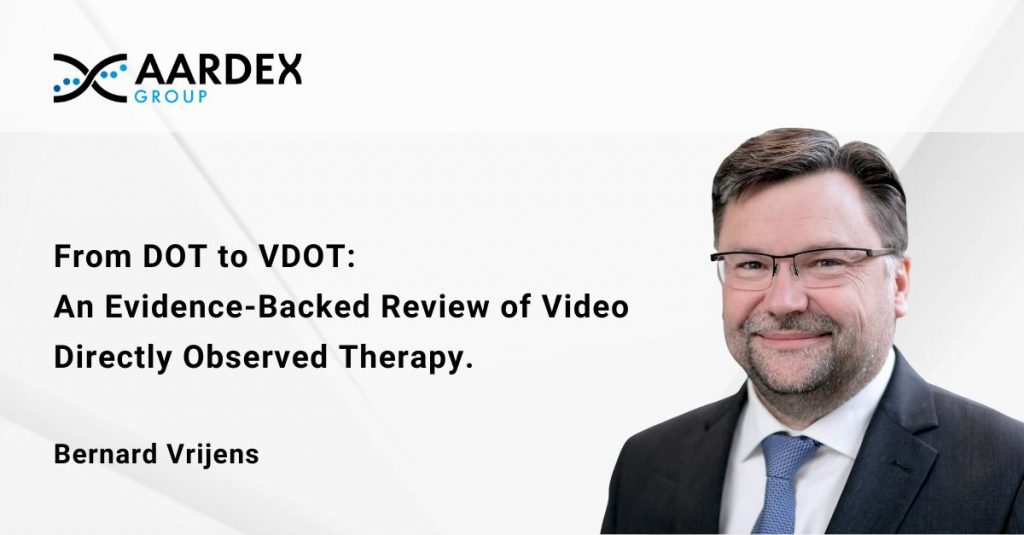Even the most efficacious medicines do not work when people don’t take them – and the same is true for digital medication adherence monitoring. Because while the approach has huge potential in clinical trials and routine practice alike, embracing the benefits relies on ensuring solutions are easy to use.
A variety of medication adherence monitoring solutions have emerged in recent years, as organizations vie to apply advanced technologies to this age-old problem. Yet some, such as those based on Video Directly Observed Therapy (VDOT), may be erecting, rather than ripping down, the barriers to optimal adherence.
A baked-in problem
Poor adherence to medication is common in both clinical trials and routine practice. An estimated 30% of study participants1 and up to half of people with long-term chronic conditions2 do not take their medicines either as set out in the protocol or as prescribed by their doctor.
It is a problem that can drain study power, potentially to the point of failure, and contribute to lower patient outcomes, including avoidable complications and even mortality – but researchers and clinicians have so far been thwarted in their attempts to overcome it.
Part of the roadblock has been a lack of workable management strategies. Self- or healthcare professional- (HCP) report is subjective and vulnerable to intentional and accidental bias, for example. Other approaches, such as measuring drug metabolites in hair, urine, or blood, and directly observed therapy (DOT) are burdensome and intrusive.
The emergence of digital medication adherence monitoring promises to shift the dial – but not all digital approaches are created equal. Success relies on ensuring people are willing and able to use the solutions we provide them.
From DOT to VDOT
DOT, or asking patients to take their prescribed dose in the presence of a HCP, has been a mainstay of adherence monitoring in some therapy areas for some time.
It is common, and successful, in phase 1 first-in-human studies that take place within a controlled environment, for example.
It has also found success in some areas of clinical practice. In the 1990s, for example, New York City employed the approach as program to tackle wide-spread tuberculosis (TB). The initiative, which cemented DOT as the standard of care for individuals at risk of poor medication adherence, saw more than 1,000 people complete their TB treatment between 1990 and 1991.3 In fact, some studies showed that, when compared to self-administration, DOT could reduce treatment discontinuation rates by 10%.4
However, the approach has failed in other settings. The resource-intensive model is not suited to areas of lower healthcare system provision. A 2016 systemic review, for example, found “very limited high-quality evidence” to show it was more effective than self-administration at achieving DS-TB cure in developing countries.5
The length and frequency of dosing regimens also impacts the efficacy of DOT. While TB treatment regimens are intense, it tends to take between four and nine months.6 Applying DOT to HIV, for example, which requires daily, long-term administration of antivirals, has proved less successful.7
What’s more, it is expensive for healthcare systems alike, can reduce patient autonomy, and is burdensome. In short, it is far from patient centric.
It is to this backdrop that video DOT (VDOT), in which patients record and submit videos of themselves taking their medicine, has emerged.
At AARDEX Group, we argue that this modern take on an old idea is far from optimal.
Imperfect baseline
Adherence management is a medical intervention, and, as such, should only be deployed according to the evidence.
To date, the literature on VDOT only compares the method to DOT. A paper published earlier this year, for example, found the percentage of completed doses under electronic DOT “was noninferior to that under in-person DOT”. The authors concluded this supported the efficacy of the technology.8
Yet DOT itself is an imperfect measure. A 2015 Cochrane Database Systemic Review of the approach in TB found it “did not provide a solution to poor adherence”.9
More recently, Larsen at al. compared the efficacy of an AI-driven video-based mobile app, which claims to provide a visual confirmation of an administered dose, to that of self-report.10
The study of 214 people calculated adherence to an anti-depressant based on concentrations of study drug at week three, four, and five, to self-reporting and self-monitoring via the video technology. While self-reported and self-monitored adherence rates were high at more than 90%, neither “agreed with exposure-based adherence”.10
“Both self-reported and self-monitored adherence overestimated adherence. Neither the self-reported nor the self-monitored adherence measure reflected subjects’ actual adherence. This prompts for cautiousness when interpreting either of them, and it underlines the need for thorough validation of electronic devices and software that claims to measure adherence,” concluded the authors.10
Verification and practicality concerns
The limitations of VDOT do not stop there, and various other areas of concern warrant further investigation.
First and foremost, the approach does not overcome the patient burden of DOT approaches. While filming themselves taking medicine may be more convenient than visiting a clinic for some, it is an unnecessary undertaking. It is time consuming and requires additional steps in the medication-taking regime. Stopping work or interrupting a day out to take a pill or administer an injection, for example, is one thing, but having to also film the process adds new layers of complexity and inconvenience.
What’s more, in a world of selfie culture, many may be uncomfortable or unwilling to record themselves in this way, particularly if they feel – or look – unwell. In terms of practicalities, finding the right camera angle to film the administration of an injection or inhaler could prove to be frustrating. It is a task that demands ability, precision, and is best carried out with three hands.
All this leads to poor image quality, which makes verifying the administration of a dose challenging. Studies have shown that patient-submitted videos and pictures are out of focus, and one found that in 23% of recorded dosing events, there is substantial missing information necessary to confirm dosing intake, for example when the patient was leaning out of the frame of view.11
It begs the questions: how can solutions be sure that the patient took the tablet, took the right tablet, or even submitted a newly recorded video from that day, for example? This is important in the light of findings from Getz et althat, when using a patient-submitted VDOT system, 4% of all confirmed doses were intentionally non-adherent, 48% of all study volunteers had at least one intentionally non-adherent dose, and 5% of were intentionally non-adherent for more than one-third of all required doses.11
Based on the available evidence, then, VDOT-based approaches are a suboptimal solution to poor medication adherence. Rather than using advanced technology to reinvent a substandard traditional approach, we should be using it to think outside the box and develop innovative new models.
Working smarter
From side effects to a lack of resources, low belief in the medication to simple forgetfulness, the barriers to optimal adherence are already plentiful. So why add more?
The most effective solutions are those that work frictionlessly, asking nothing more of patients than for them to take their medicine. That’s why AARDEX Group advocates for an ecosystem approach that combines medication adherence packaging and devices with data analytics.
Systems, which might include a smart bottle cap or blister pack for example, timestamp use in real time and transmit that information to a cloud-based platform for analysis. Proprietary algorithms then work to spot missed doses or erratic dosing patterns that could be cause for concern. Patients are directly empowered through the MEMS® Mobile app that can be used to visualize the adherence behavior, set reminders, and, if needed, to enrich the dosing history data (e.g. adjusting the timing of a pocket dose). This allows HCPs to identify those at risk, and work with them to prepare and deliver individualized interventions.
Not only is this form of digital adherence monitoring holistic and frictionless for the patient, but it is also evidence backed – studies have shown it to be 97% accurate, compared to 60% for pill count, and just 27% for self-report.12
It’s time to start thinking outside of the medicine box.
References:
- El Alili, M., Vrijens, B., Demonceau, J., Evers, S. M., & Hiligsmann, M. (2016). A scoping review of studies comparing the medication event monitoring system (MEMS) with alternative methods for measuring medication adherence. British journal of clinical pharmacology, 82(1), 268-279.
- Sabaté, E., & Sabaté, E. (Eds.). (2003). Adherence to long-term therapies: evidence for action. World Health Organization.
- Klein, S. J., & Naizby, B. E. (1995). Creation of a tuberculosis directly observed therapy provider network in New York City: a new model of public health. Journal of Public Health Management and Practice, 1-6.
- Coêlho, A. A., Cobucci, R. N. O., Freitas, E. M. N., Lima, P. H., & Brito, E. W. G. (2017). A Meta-Analysis of Directly Observed Treatment vs. Self-Ad-ministered Therapy Outcomes in Pulmonary Tuberculosis Patients. Journal of Infectious Diseases and Epidemiology, 3(1), 1-7.
- McLaren, Z. M., Milliken, A. A., Meyer, A. J., & Sharp, A. R. (2016). Does directly observed therapy improve tuberculosis treatment? More evidence is needed to guide tuberculosis policy. BMC infectious diseases, 16(1), 1-4.
- Centers for Disease Control. (2022). Treatment for TB Disease. Available at: https://www.cdc.gov/tb/topic/treatment/tbdisease.htm#:~:text=RIPE%20regimens%20for%20treating%20TB,to%209%20months%20for%20treatment).&text=This%20is%20the%20preferred%20regimen%20for%20patients%20with%20newly%20diagnosed%20pulmonary%20TB. Last accessed: 3 August 2022
- Wohl AR. Garland WH. Valencia R, et al. A randomized trial of directly administered antiretroviral therapy and adherence case management intervention. Clin Infect Dis. 2006;42(11):1619–1627.
- Burzynski, J., Mangan, J. M., Lam, C. K., Macaraig, M., Salerno, M. M., deCastro, B. R., … & eDOT Study Team. (2022). In-person vs electronic directly observed therapy for tuberculosis treatment adherence: A randomized noninferiority trial. JAMA network open, 5(1), e2144210-e2144210.
- Karumbi, J., & Garner, P. (2015). Directly observed therapy for treating tuberculosis. Cochrane database of systematic reviews, (5).
- Larsen, K. G., Areberg, J., & Åström, D. O. (2021). Are self-reported and self-monitored adherence good proxies for reaching relevant plasma concentrations?: Experiences from a study of anti-depressants in healthy volunteers. Clinical Trials, 18(4), 505-510.
- Getz, K., Smith, Z., Shafner, L., & Hanina, A. (2020). Assessing the scope and predictors of intentional dose non-adherence in clinical trials. Therapeutic Innovation & Regulatory Science, 54(6), 1330-1338.
- El Alili, M., Vrijens, B., Demonceau, J., Evers, S. M., & Hiligsmann, M. (2016). A scoping review of studies comparing the medication event monitoring system (MEMS) with alternative methods for measuring medication adherence. British journal of clinical pharmacology, 82(1), 268-279.



